Health and Disease of the Equine Frog
Treatment Studies
Josephine Trott, PhD, Assistant Project Science, Dept. of Animal Science of University of California, Davis, has conducted a comparative study of various treatments over the course of several weeks. Her careful documentation and quality photography effectively illustrate the results she achieved with various products and protocols. Josephine's report follows:
Introduction
Both of my horses had deep central sulci on their front feet and one had deep central sulci on his hind feet. I was not able to get to the bottom of some holes even with a 1 inch hoof pick. Daily antibiotic treatments worked for a short time but soon became ineffective. 40% bleach was too caustic to the frog and sole. A solution of 0.5% gentian violet and 0.5% iodine was ineffective, as was diluted Lysol spray, 50% vinegar spray or 40% zinc oxide cream. I needed an agent that promoted healing of the frog, and while topical antiseptics kept the surface thrush under control, they were not healing the deeper structures of the hoof. I discovered Oxine AH, and a new product called No Thrush and decided to experiment, first comparing No Thrush with Oxine soaks, and later comparing No Thrush to Thrush Stop.
Methods and Results
21 day No Thrush and Oxine AH comparison
Eight hooves on two horses (A and B) were included in the treatments. The two front hooves of Horse B were assigned to receive Oxine AH soaks in soaking boots (Clean Trax brand) and No Thrush treatment on alternate days (Fig. 1+2).
The two front hooves of Horse A were assigned to receive Oxine AH soaks only using Davis soaking boots (Fig. 3).
The four hind hooves of Horses A (Fig. 4+5) and B (Fig. 6+7) received No Thrush treatment only.
Feet were picked clean twice daily with a hoof pick. Frogs were debrided of necrotic tissue about twice a week. Every morning, immediately prior to treatment and after picking them clean, all hooves were scrubbed and washed with dish detergent and a stiff bristled brush until the foam was white or nearly white. Hooves to be treated with Oxine AH received cotton wool inserted into any central sulci large enough to hold the cotton wool and were then placed into soaking boots.
Oxine AH was activated using 1/4 tsp citric acid per 30 ml Oxine AH, mixed and allowed to sit for at least 3 minutes, then diluted with 1L of deionized water. Oxine AH soaks lasted 20 - 30 min and hooves were immersed in liquid to the coronet band. During this time, the hooves to be treated with No Thrush were allowed to air dry by standing the horse in clean shavings and a stiff bristle brush and dog tooth scraper were then used to remove any remaining dirt/manure in the lateral sulci and central sulci. When necessary, cotton wool was inserted into the central sulci and a hoof pick used to scrape the cotton wool through the gap to further clean out dirt and manure.
Central sulci were filled and the lateral sulci were dusted with No Thrush, as well as any areas of the frog that appeared to be white and crumbling or otherwise showed evidence of decay. Following an Oxine AH soak, hooves were left to dry (Horse B) or in the case of Horse A , towel dried and 40% zinc oxide cream applied, with dry cotton wool inserted into the central sulci if space permitted.
Photographs were taken on Day 1 (the start of the soaking treatments or NT treatments), Day 8, Day 15 and Day 22. All 8 feet were then treated for 21 days with No Thrush alone, using the methods described above, and photographed on Day 43. Hooves treated with NT alone were started 5 days before the soaking comparisons so their final picture was taken on day 48.
In my experience, the combination of Oxine soaks and No Thrush (Figures 1 and 2), or No Thrush alone (Figures 4 - 7) was more effective than three weeks of Oxine soaks alone (Figure 3).
Figure 1. Three weeks of Oxine soaks alternating with No Thrush (NT) followed by three weeks of daily NT (Left Front Horse B).
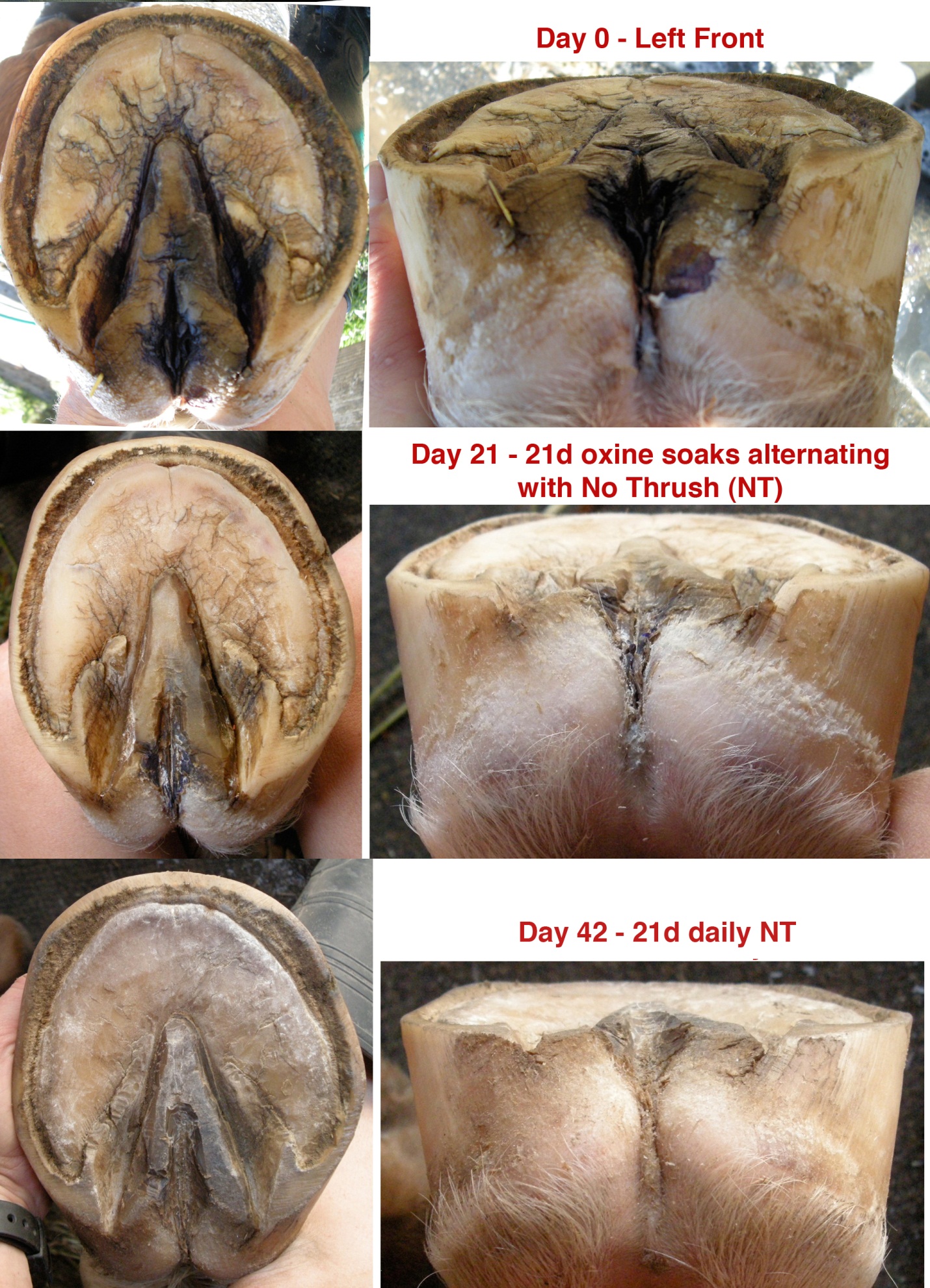
Figure 2. Three weeks of Oxine soaks alternating with No Thrush (NT) followed by three weeks of daily NT (Right Front Horse B).
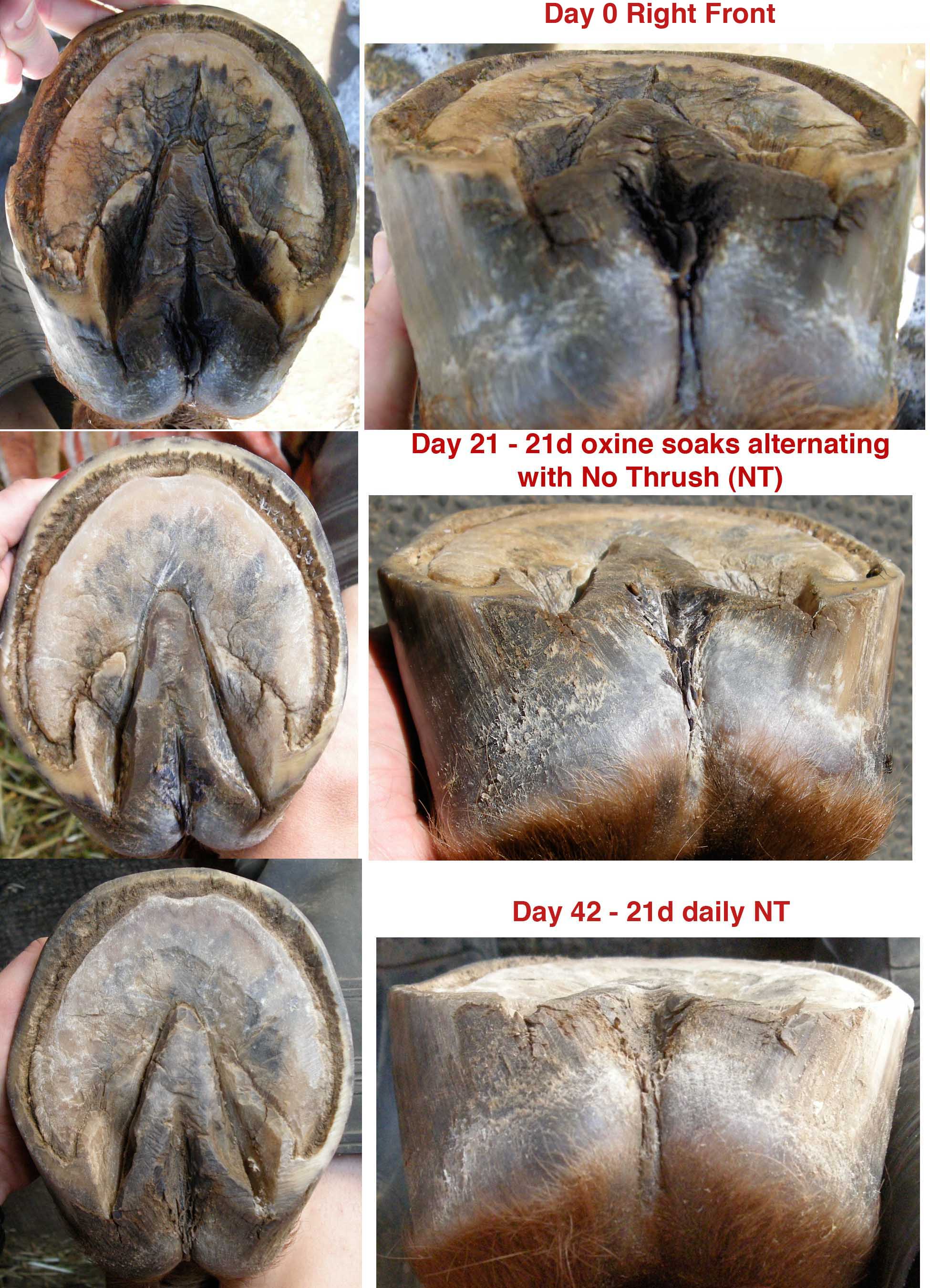
Figure 3. One week of daily Oxine soaks, two weeks of Oxine soaks every second day, then three weeks of daily No Thrush (Right Front, Horse A).

Three weeks of treatment that included daily or every second day of dusting with No Thrush produced frogs that were not sensitive anymore. The depth of the central sulcus was 50% shallower and the frog tissue was overall much firmer with no significant areas of surface thrush/cheesy frog. By comparison, the two Oxine AH soaked frogs were still sensitive to pressure, still had deep central sulci and significant surface thrush. These Oxine soaked feet were treated for a further three weeks with No Thrush daily. The No Thrush produced significant healing, the central sulci grew out and surface thrush was much reduced (Figure 3). One of these feet did not lose sensitivity to pressure deep in the central sulci until 4 weeks after daily No Thrush treatment was initiated (data not shown). The four hind feet varied in their time for healing, based on how deep the central sulci were at the start of the treatments. One hind foot was healed after 19 days of No Thrush treatment (Figure 4), a second took 26 days (Figure 5), while the third (Figure 6) and fourth took 6 1/2 weeks (Figure 7).
Figure 4. Nineteen days of No Thrush treatment (Right Hind, Horse A).
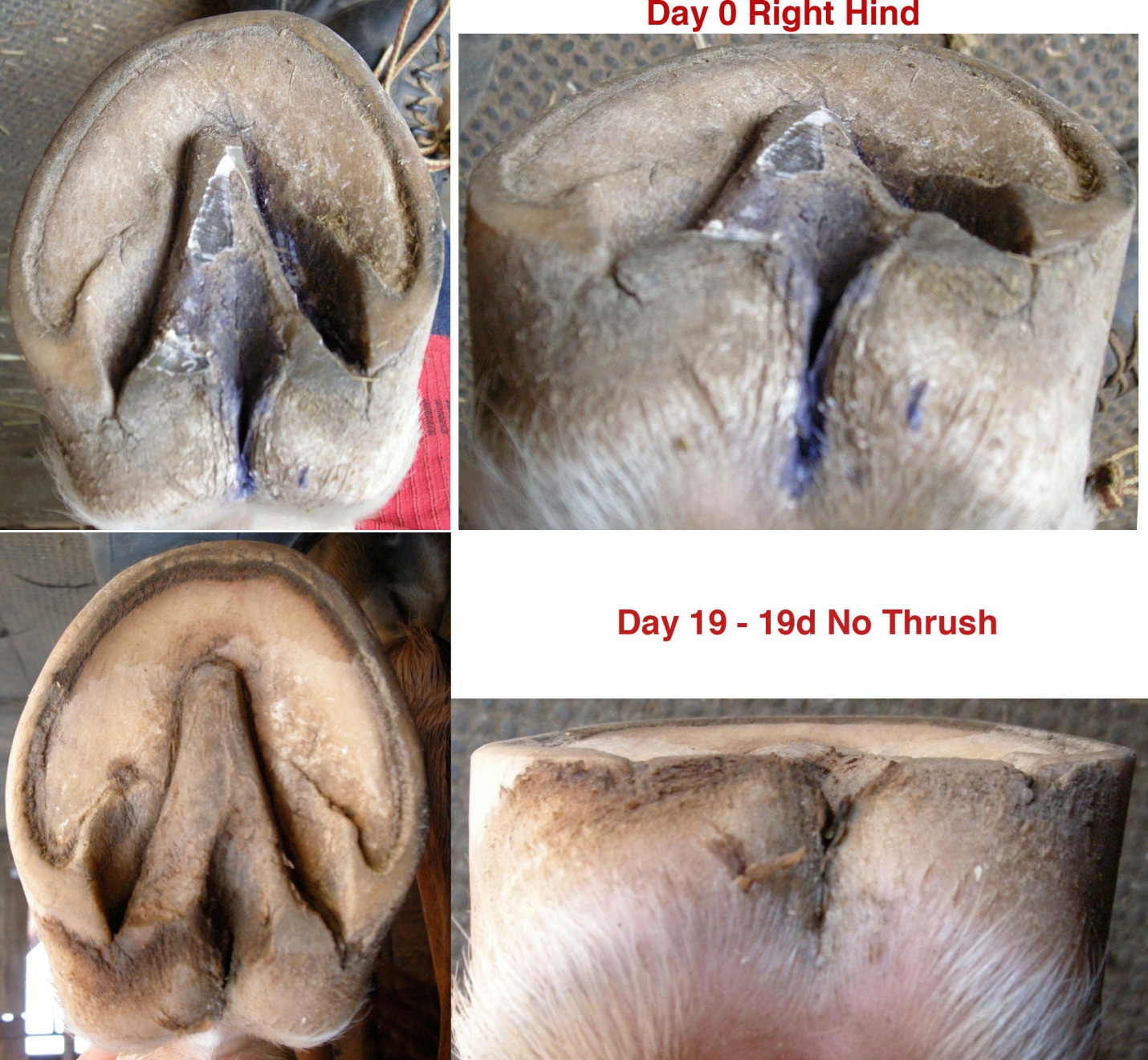
Figure 5. Twenty six days of No Thrush treatment (Left Hind, Horse A).
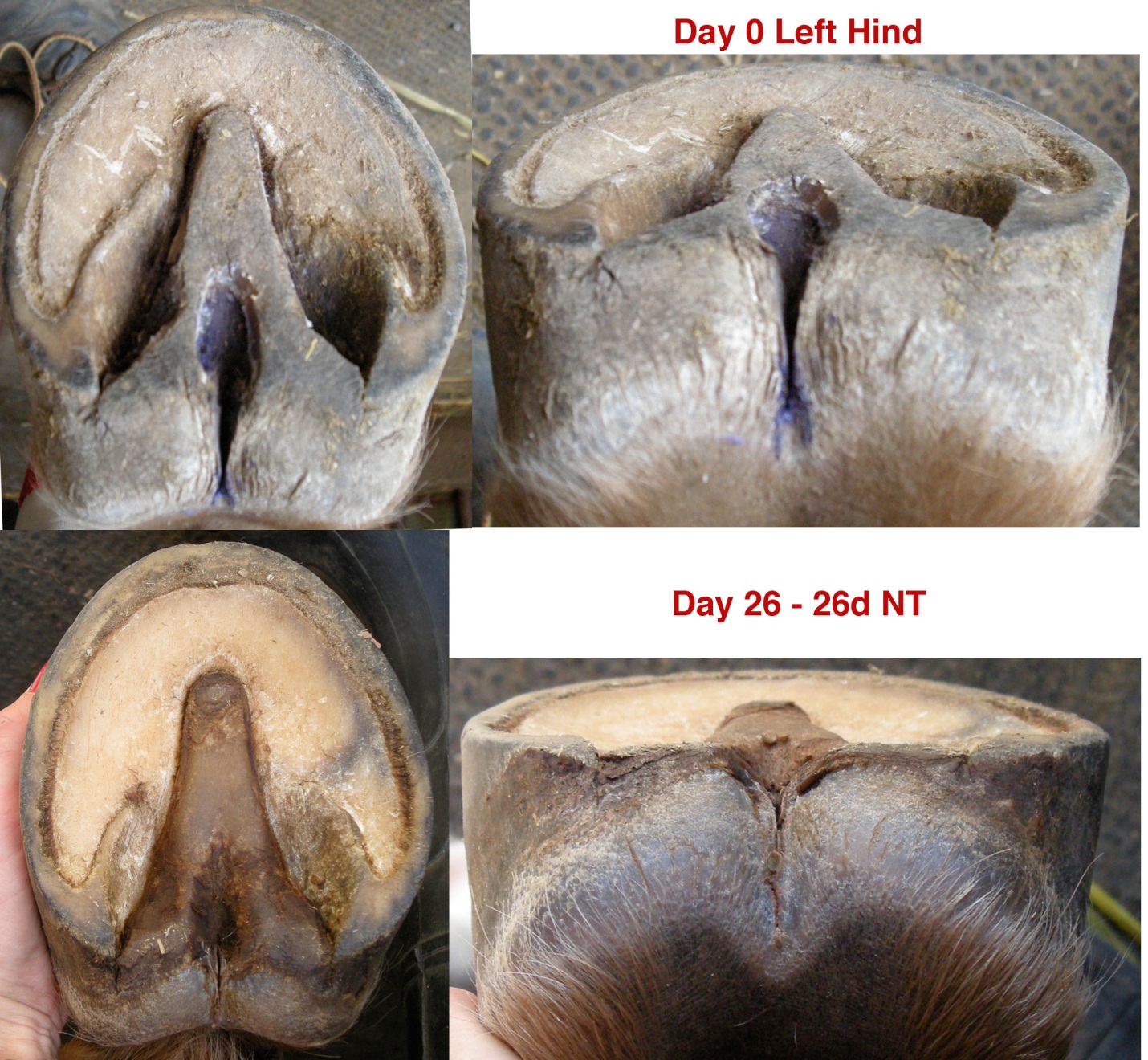
Figure 6. Six and 1/2 weeks of daily No Thrush (Left hind, Horse B).
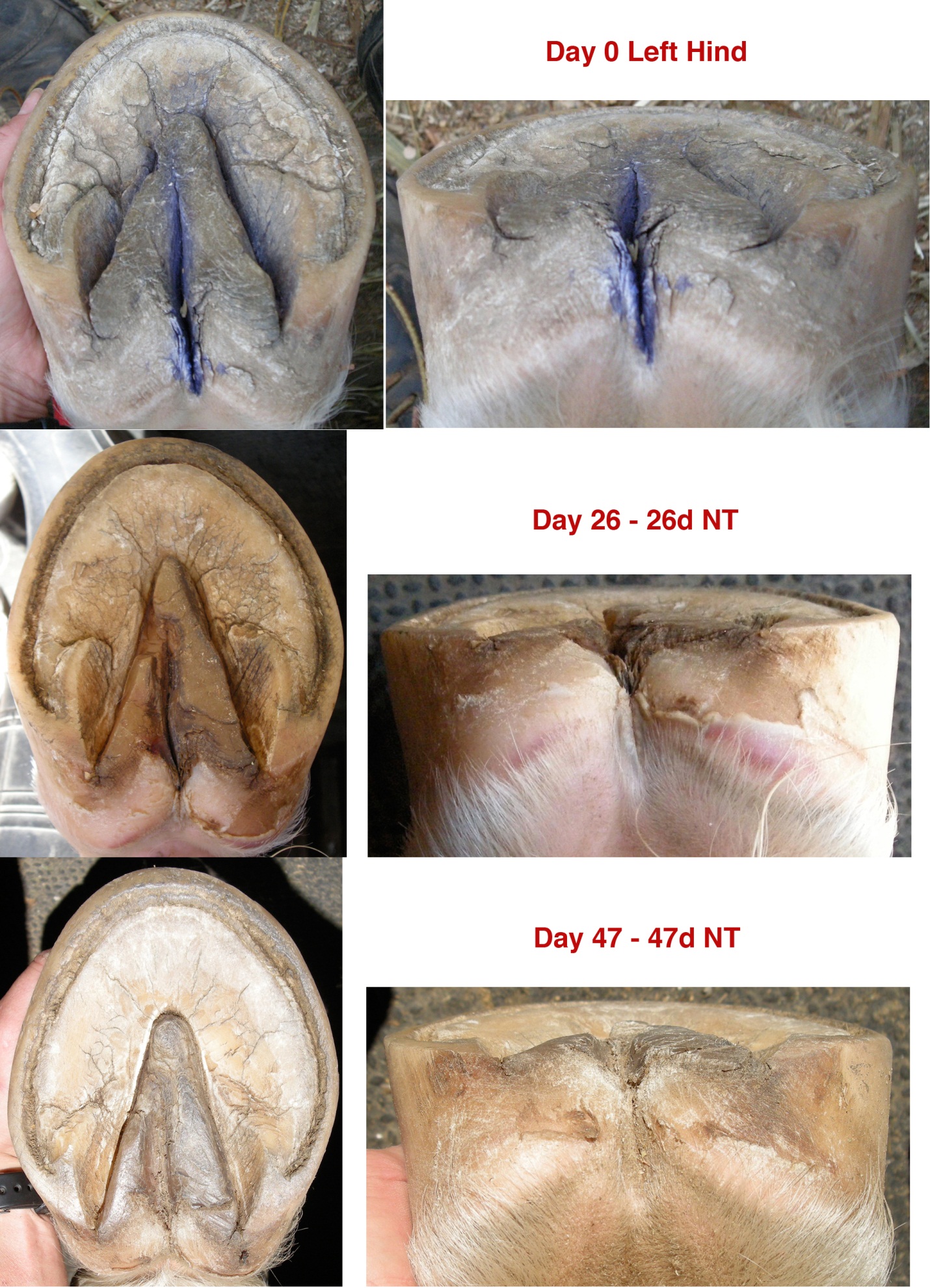
Figure 7. Six and 1/2 weeks of daily No Thrush (NT). Right Hind Horse B.
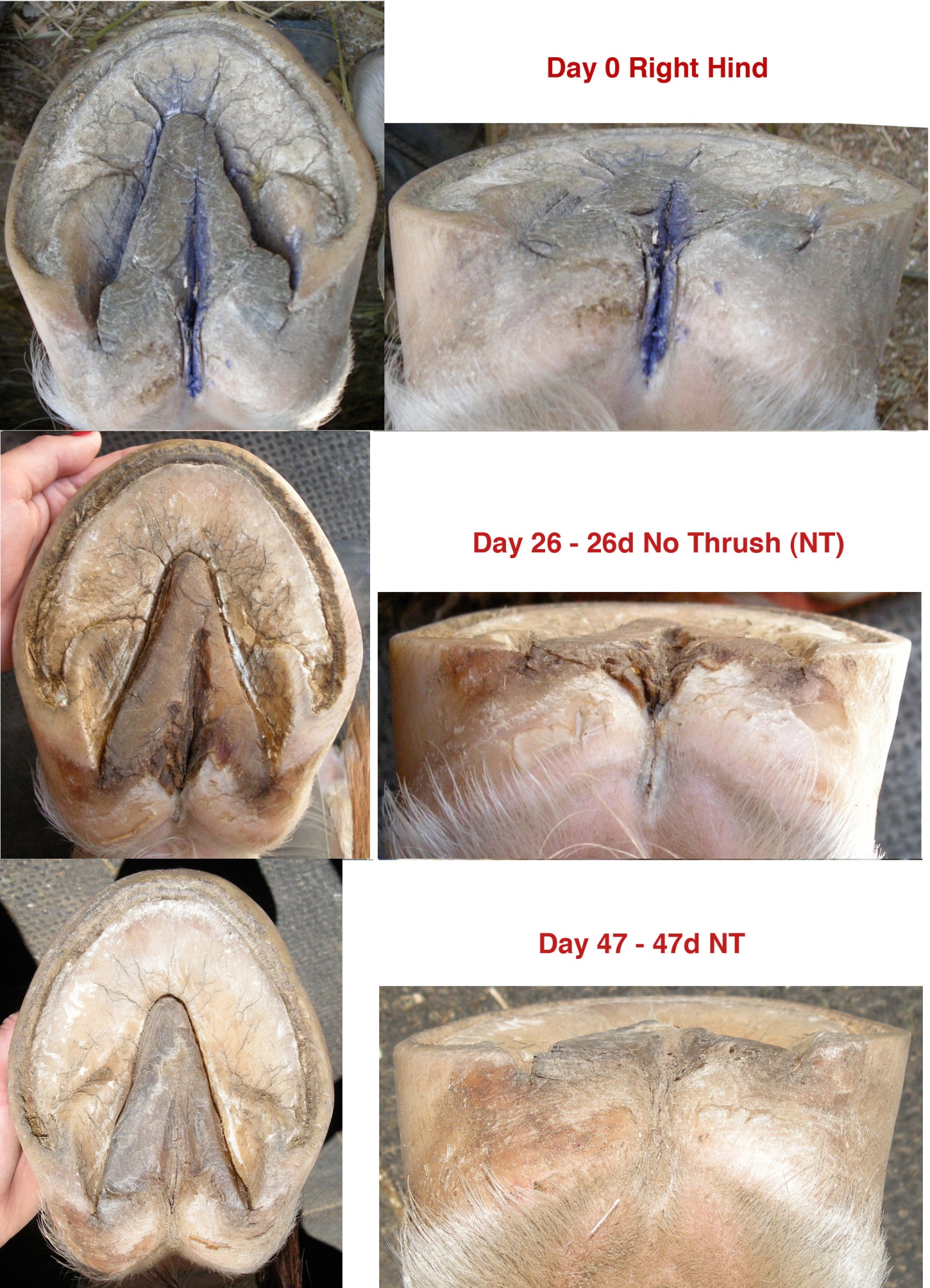
5 day No Thrush Treatment
After 3 weeks of Oxine soaks, two hooves on one horse (A) were treated every morning with No Thrush for 5 days (continuing for another 16 days thereafter). The hooves were cleaned, dried and treated with No Thrush as described above. Photographs were taken the day before the first treatment (on Day 0) and on Day 6 (one day after the 5th day of treatment; Figure 8). Five days of No Thrush did not produce any significant changes in the central sulci. However, the author has observed that surface-thrush infected frogs will respond nicely to as few as 3-5 days of No Thrush treatment.
Figure 8. Five days of daily No Thrush following 3 weeks of Oxine soaks on two front feet (Horse A)

21 days No Thrush versus Thrush Stop
Two front feet that still had deep central sulci, although not sensitive to pressure anymore, were used in a cross-over treatment comparison between No Thrush and Thrush Stop. Each foot was treated for 3 weeks with either No Thrush or Thrush Stop and then the treatments were swapped between the two feet and continued for another 3 weeks. Cleaning and debridement was performed as described above. Comparison of daily No Thrush and Thrush Stop on two front feet for 21 days produced similar results. Each frog maintained a tightly closed central sulcus and minimal surface thrush (Figures 9 &10).
Figure 9. Maintenance comparisons. Three weeks of daily No Thrush (NT) then three weeks of daily Thrush Stop, then 3 weeks of daily cleaning with twice weekly NT. (Left Front, Horse A)
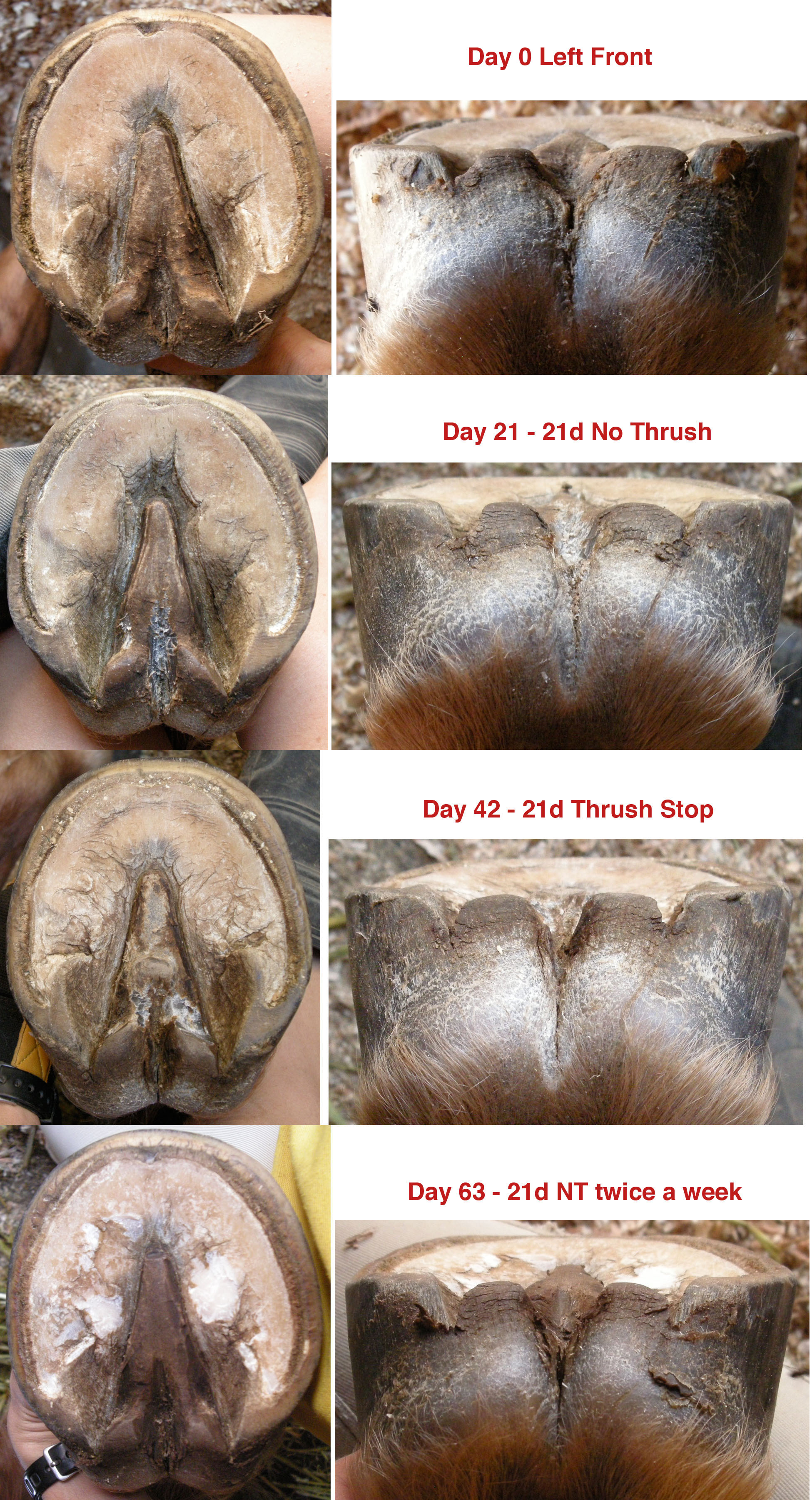
Figure 10. Maintenance comparisons. Three weeks of Thrush Stop then three weeks of No Thrush, then 3 weeks of daily cleaning. (Right Front, Horse A).
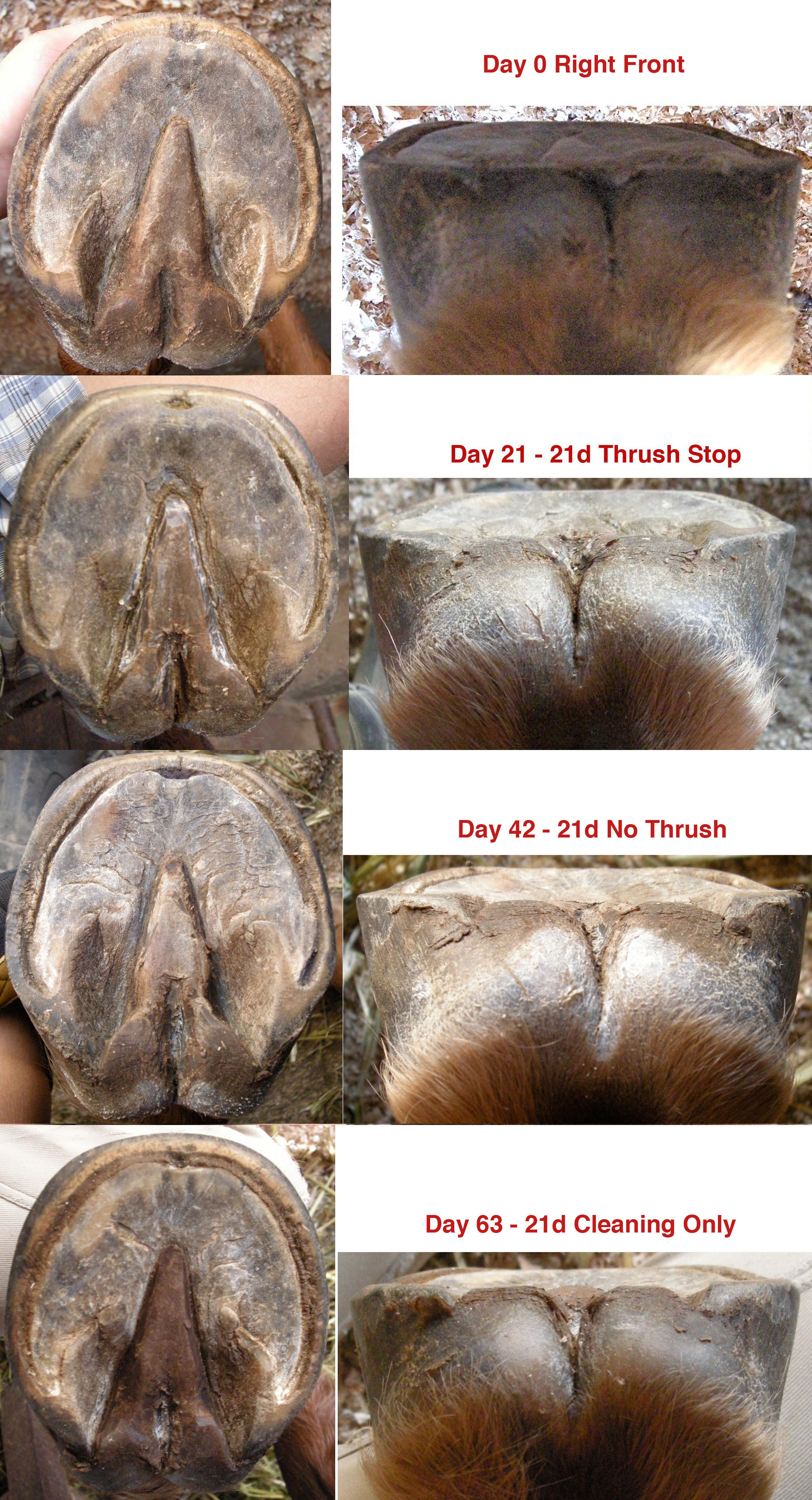
21 days Cleaning versus Minimal Treatment (data not shown)
All eight feet were cleaned twice daily as described for the No Thrush versus Oxine treatments. Three feet were treated with No Thrush twice a week. Two feet were treated with an Oxine soak once a week. Three feet were cleaned only. One frog that was being treated only twice a week with No Thrush got worse, with the central sulcus opening up and getting deeper (Figure 9), while the contralateral frog, that was only being cleaned daily and not treated at all, didn’t regress much (Figure 10). One hind foot receiving Oxine soaks once weekly stayed very healthy, while the contralateral frog, receiving the same treatment, regressed with the central sulcus becoming noticeably deeper (data not shown).
Conclusions
I found No Thrush to be more effective than Oxine soaks for healing chronic central sulcus thrush and treating surface patches of thrush. In retrospect, my eight months of treatment prior to initiating this series of experiments failed to work effectively partly because I wasn’t cleaning and debriding the frog appropriately to expose pockets of infected material and prevent accumulation of manure and dirt, and partly because my treatment solutions couldn’t treat the central sulcus thrush and promote healthy growth as effectively as No Thrush. I found that individual horses kept in the same conditions (stall plus a 30ft yard) can differ quite dramatically in how clean they keep their feet, which in turn affects how fast their frogs start degrading if not cleaned and treated daily. Just 12 hours of being packed with manure can precipitate degradation of solid frog tissue into white, crumby and smelly tissue.
While I believe thrush is caused by accumulation of dirt and manure, for some horses, under certain conditions, even keeping their feet clean twice a day was not enough to prevent reinfection of the frogs. However, the individual hoof susceptibility to infection should also be noted, as I found one hoof (out of n=8), maintained good form with cleaning and debridement alone for 3 weeks, while others degraded before my eyes with the same treatment protocol. The jury is still out as to whether Oxine soaks once a week can prevent thrush better than daily cleaning. Unfortunately I have not compared Thrush Stop to No Thrush on frogs with very deep central sulci to examine the rate of healing from each. While my preliminary results would indicate that Thrush Stop should be as effective as No Thrush to heal chronic central sulcus thrush, this remains to be established.
More Examples
The examples below illustrate the effectiveness of other treatment methods administered by private owners. Full healing has not been achieved in most cases, but progress is evident.
Owner A:
“…These are the left (Fig. 11 a) and right front (Fig. 11 b) before and after using Pete's Goo for 2 weeks. The thrush was so deep that it took a full 20cc syringe to fill the hole under the frog! The after pictures are 2 months into treatment. After the first 2 weeks I started using White Lightning 2 times a week and continued using Pete's Goo every day in between. I quit using the Pete's Goo when the "slit" between the heel bulbs filled in as shown in these photos but continued to soak about once a week with the WL until I had good healthy frog. Now they are perfect and none of the gunk has come back!”
Figure 11 a. Left front before and after Pete’s Goo
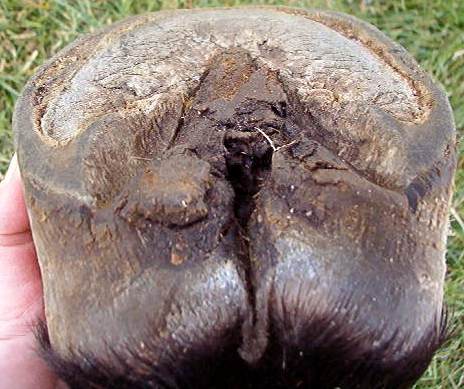

Figure 11 b. Right front before and after Pete’s Goo
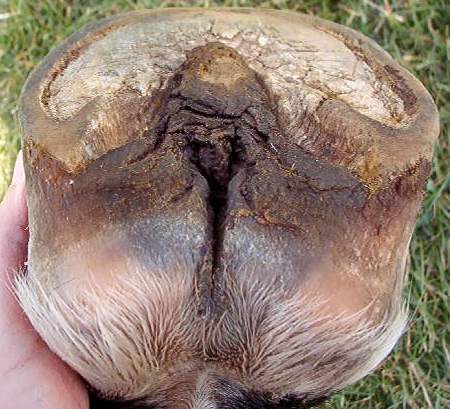
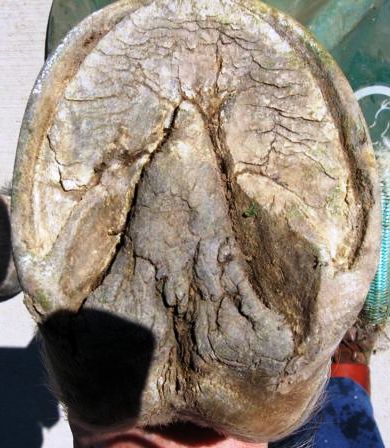
Remarks: Healing would be facilitated by debridement or removal of diseased tissue. Although significant progress is apparent, there is still room for improvement by our standards.
Owner B:
“…I read an article in The Horse's Hoof magazine written by Candy Platz and Heike Bean, and it could have been written about my horse. With help from Candy I learned that it is hard to keep a horse's feet healthy here in the Northeast where we have 6 months of snow and mud. I learned how to thoroughly clean my horse's feet and how to trim the frogs so there were no flaps to hold dirt and to get rid of the dirt line in the collateral groove. I started soaking all four of her feet with White Lightning three times a week for about three weeks. Then twice a week for two weeks. Then once a week for two weeks.
They responded quickly. Now I soak once a month unless I find some smelly dirt anywhere on her foot.”
Figure 12 a. Left front before and after WL protocol described above, now on maintenance.

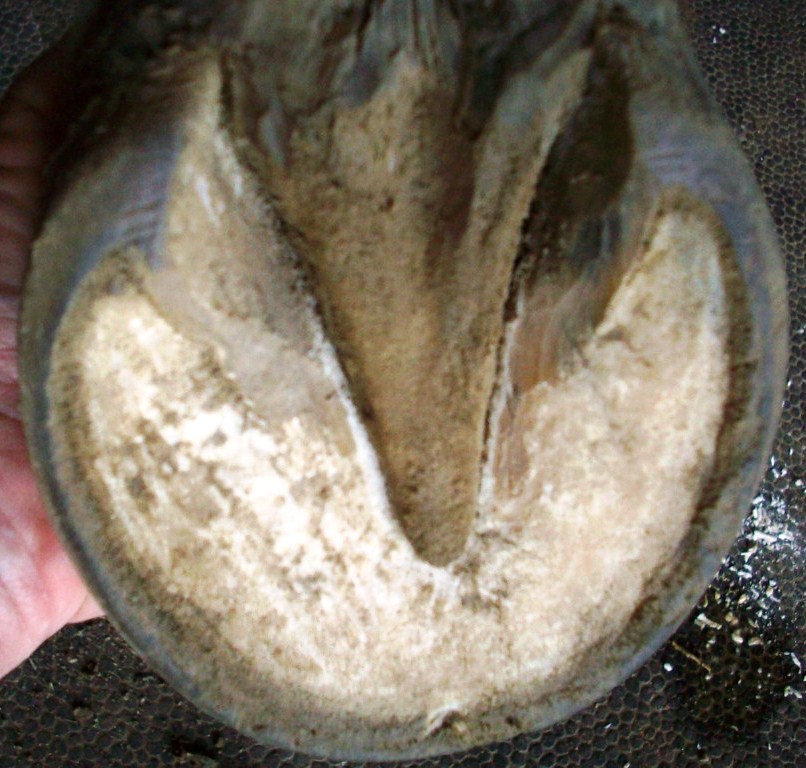
Figure 12 b. Right front before and after WL
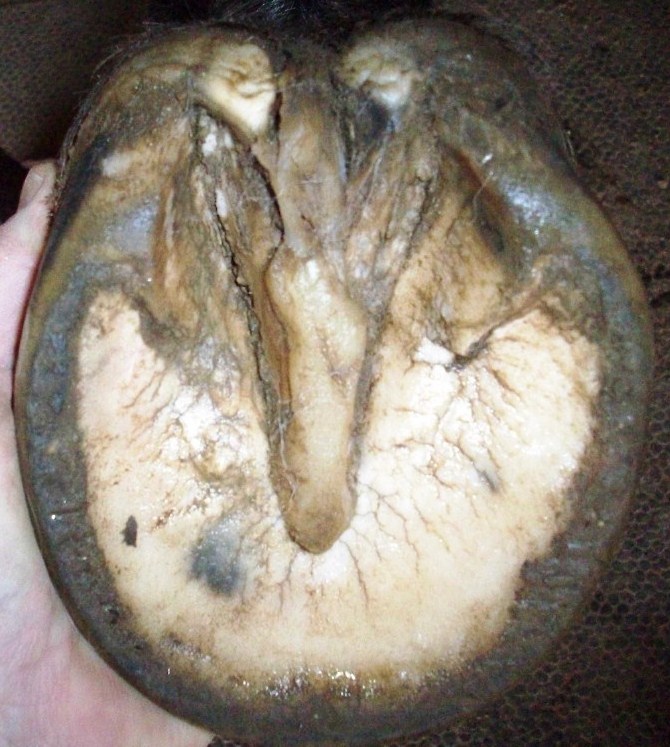
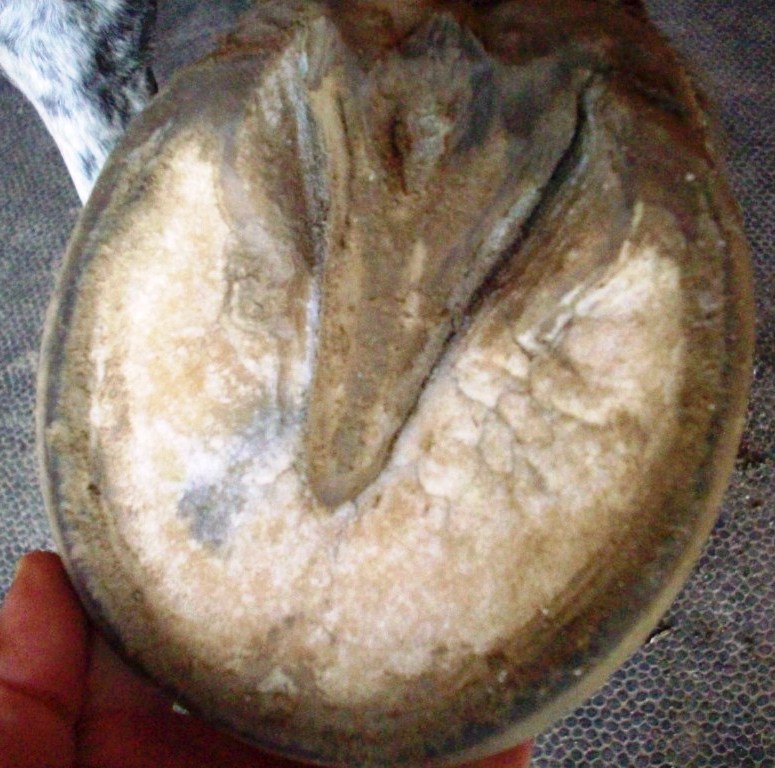
Figure 12 c. Left hind before and after WL
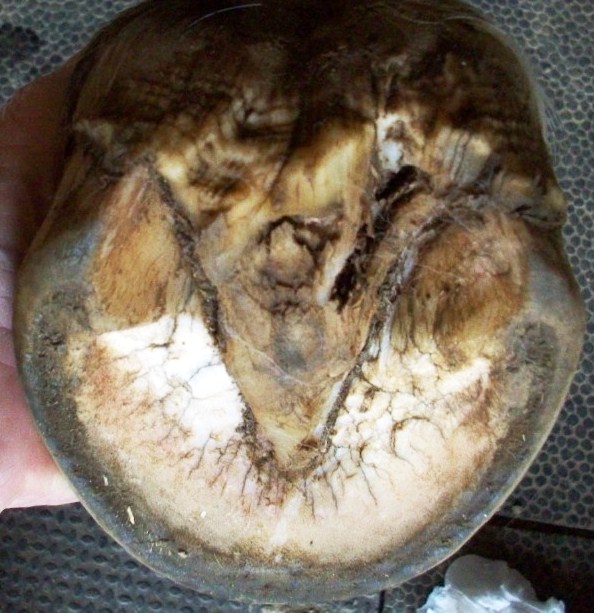

Figure 12d. Right hind before and after WL
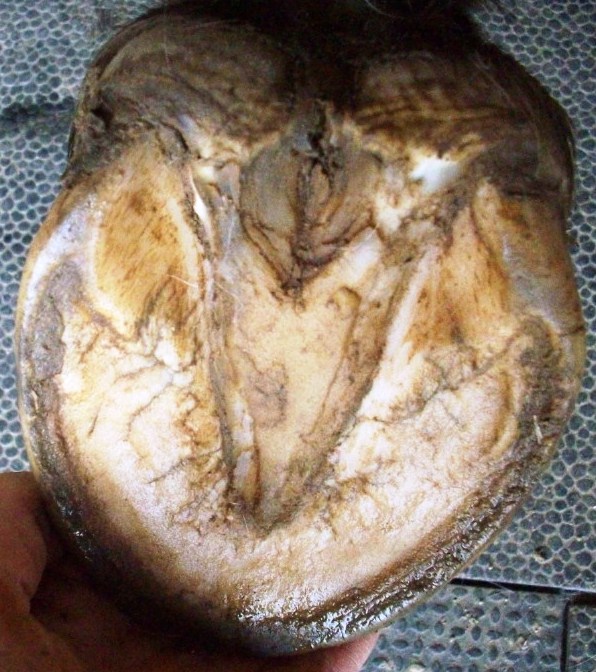
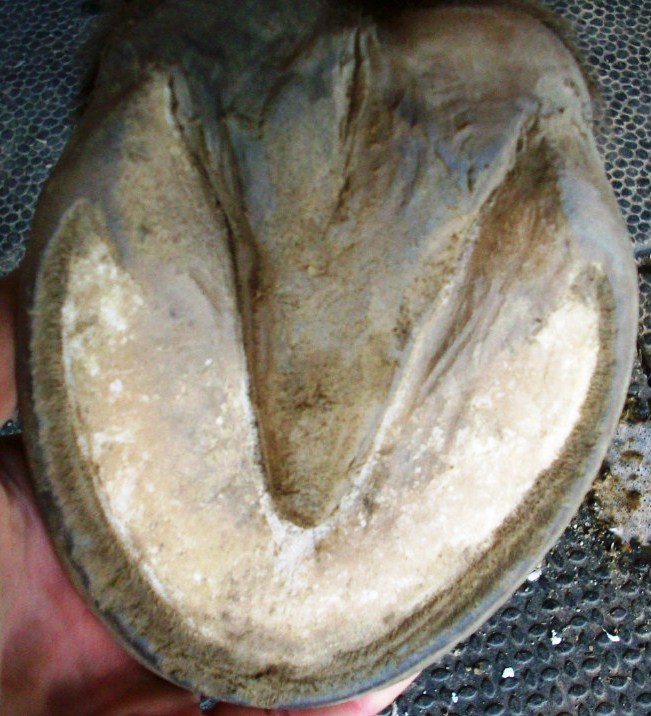
Owner C
“…I found that I got big improvements when I cut out all the diseased frog on my horse's feet, then followed with white lightning soaks and topical betadine. Here's a comparison picture (Fig. 13) I made of one hoof. This is the hind left over a period of 2 months. Pictures are dated. In the first one I had carved out the frog, the second it is recovering well and the 3rd it has filled in and expanded”
Figure 13. White Lightning treatment, followed by topical Betadine

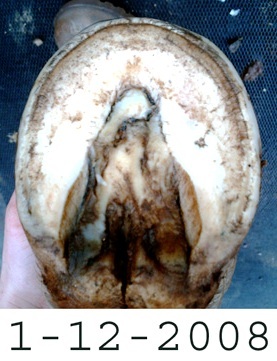
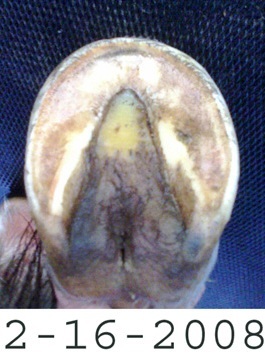
Once again, we see both significant healing and room for improvement in the above example.
Owner D:
Figure 14 shows an example from Cheryl Henderson of a hoof treated only once with White Lightning:
Figure 14. Same hoof before and after one White Lightning treatment
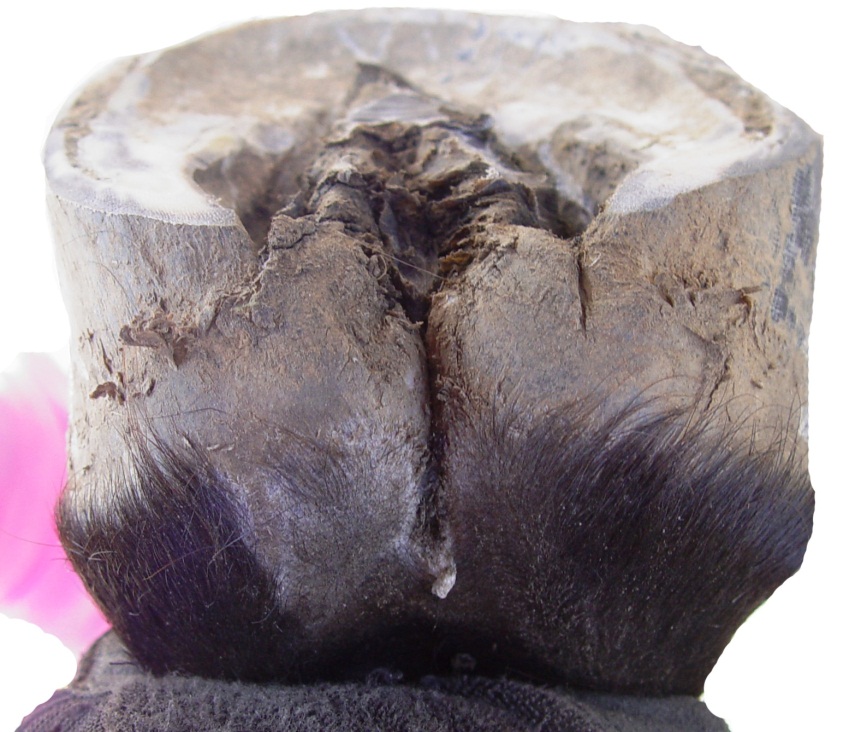

Owner E:
Two
Year Study of one of the Author’s horses:
The 3 hooves
shown below in Fig. 15 a & b through Fig. 17 a & b were
initially treated almost daily with Life Data Hoof Disinfectant.
Prior to treatment, these frogs lacked a central sulcus and appeared
plump and large. After trimming the flaps overlying the collateral
grooves significant disease was detected, as well as the telltale
sour onion smell. Although the horse was never clinically lame, his
trot was conservative and somewhat guarded. As his frogs healed, his
movement changed to become more expressive and suspended with strong
extension of the forelimb.
Central sulci gradually appeared, becoming deeper and wider with treatment. Some sulci were transiently sensitive to probing. During the first weeks of treatment, new crevices and holes were revealed.
Figure 15 a. RF after 3 months of almost daily Life Data Hoof Disinfectant

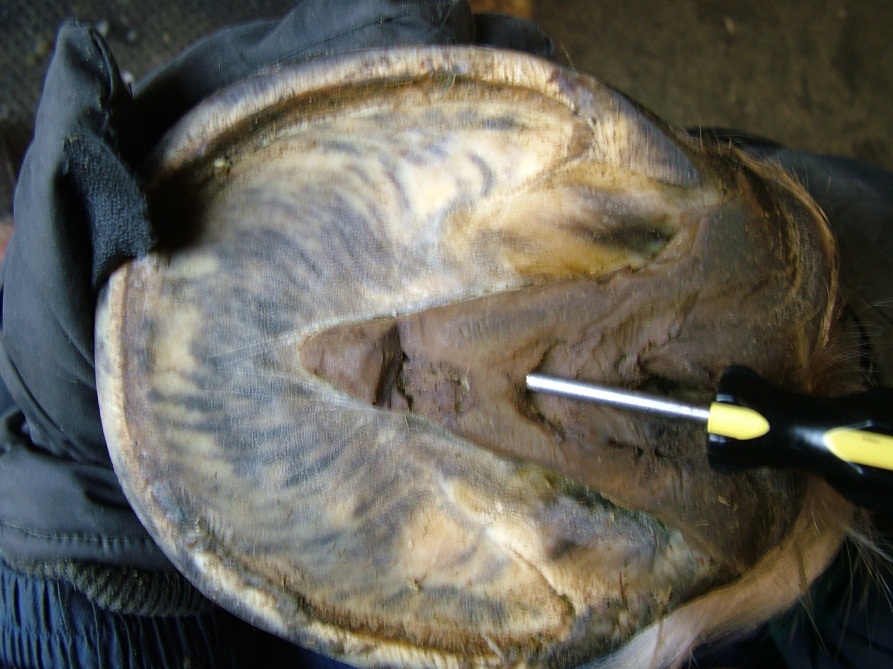
After 3 months with Life Data, White Lightning soaks were used 2 to 4 times a week for the next six months. Hoof Magic was applied on days without the WL treatment. (Fig. 15 b)
Figure 15 b. RF after an additional 6 months of periodic WL treatment and Hoof Magic


Figure 16 a. LF of the same horse after 3 months of almost daily Lifedata Hoof Disinfectant
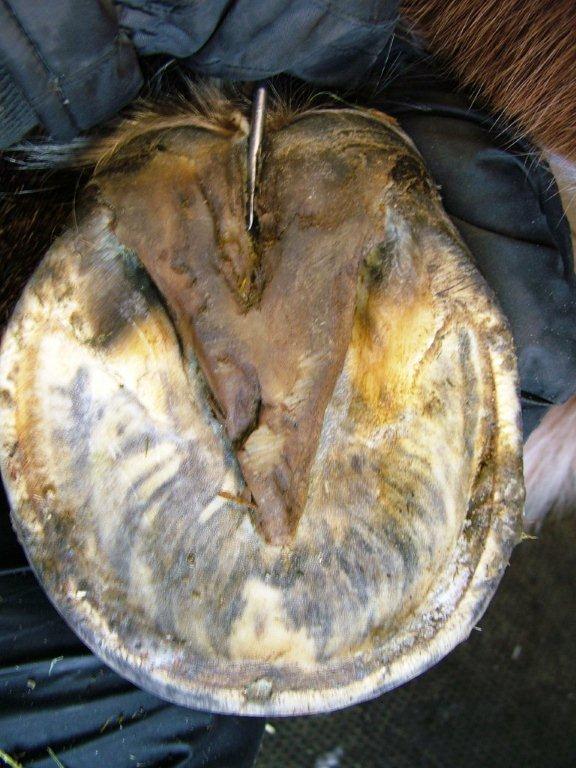

Figure 16 b. LF after 6 months of periodic WL and Huuf Magic treatment
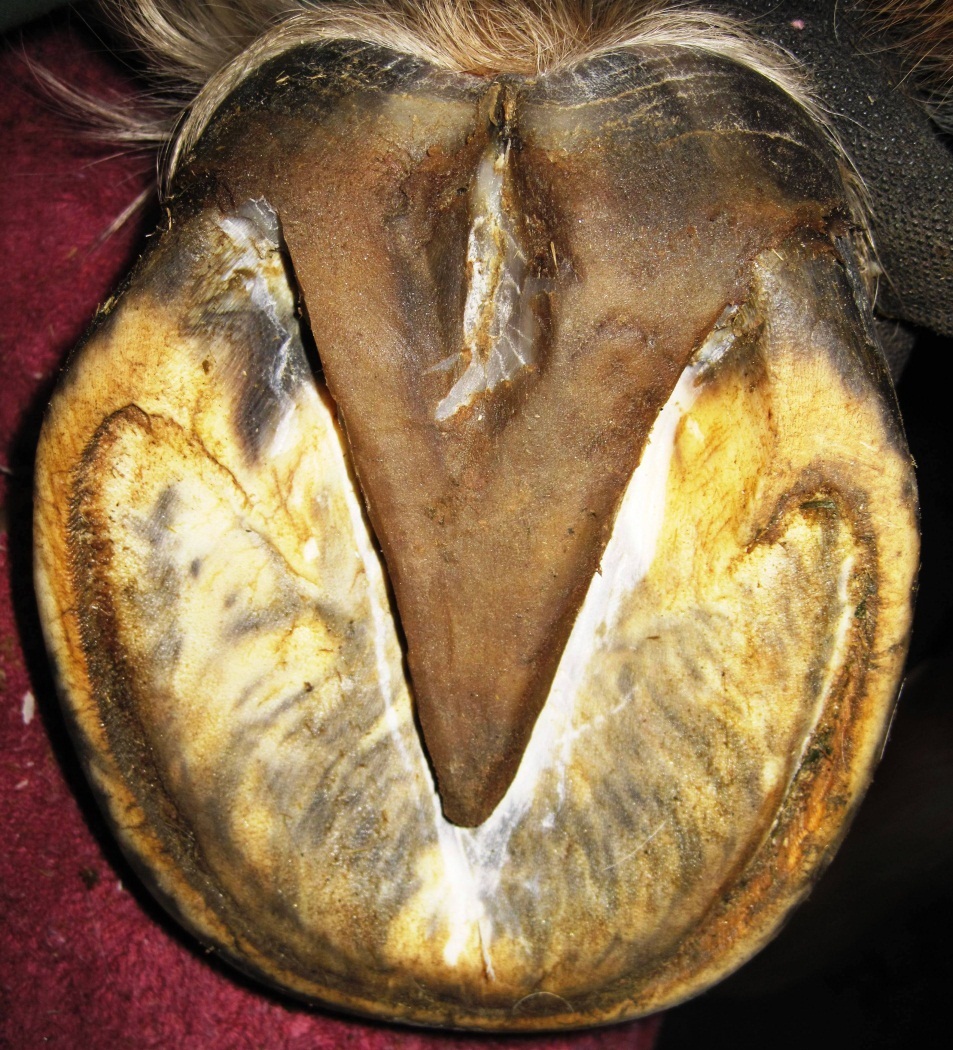
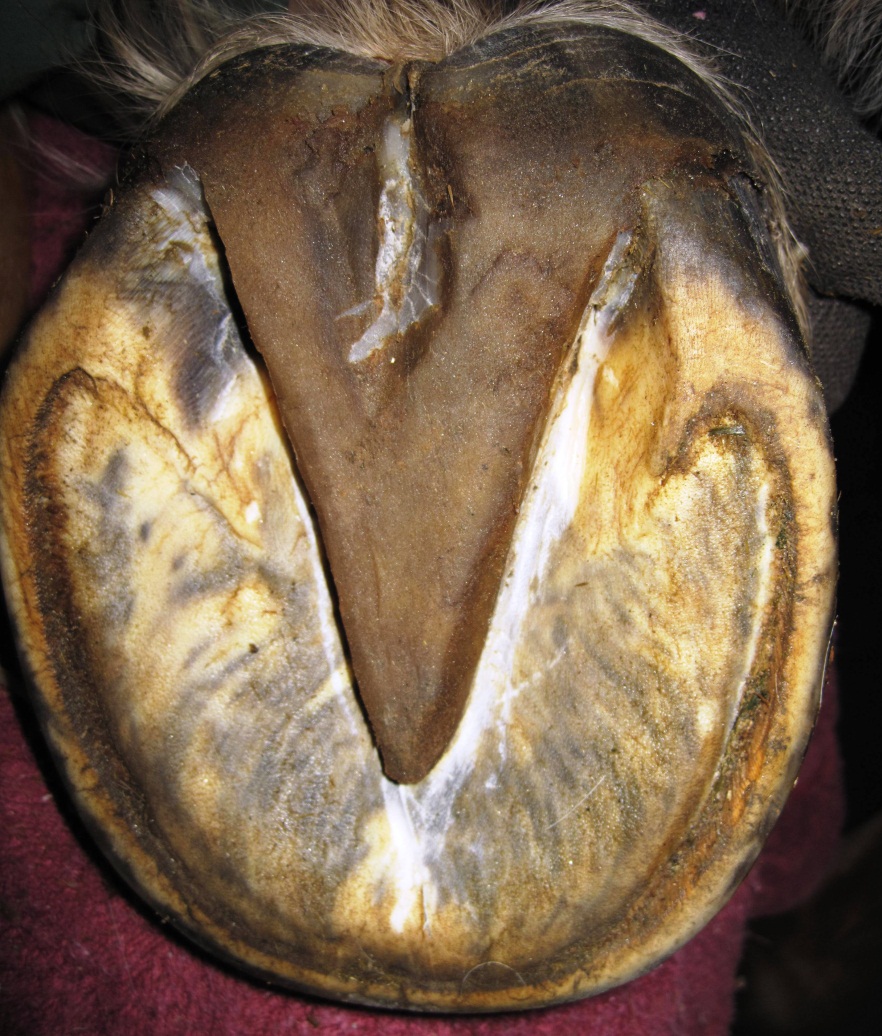
Figure 17 a. LH after 3 months of almost daily Life Data Hoof Disinfectant
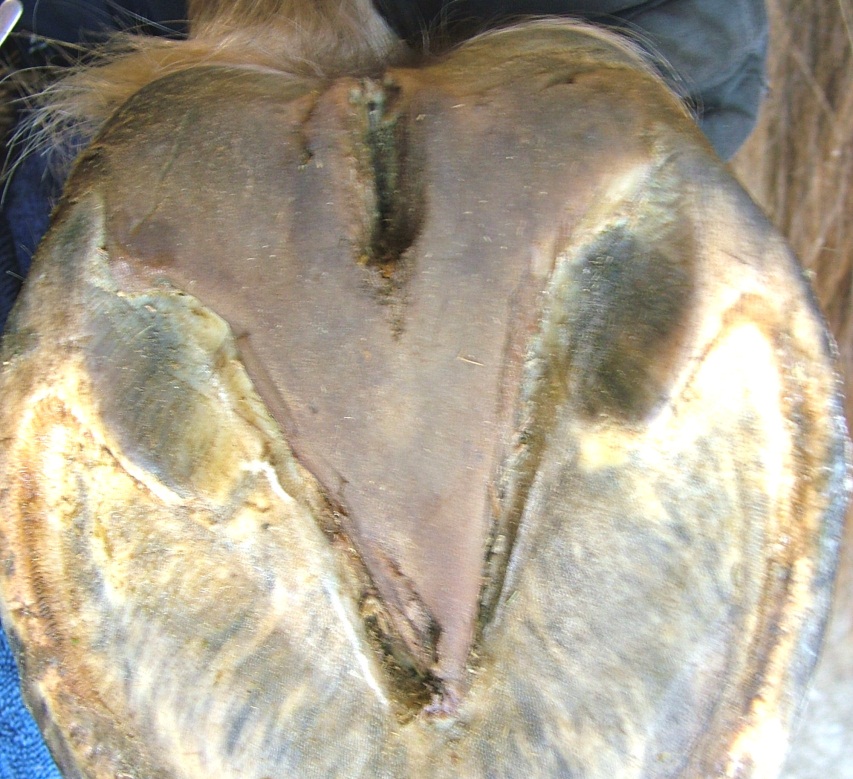

Figure 17 b. LH after 6 months of periodic WL and Huuf Magic treatment

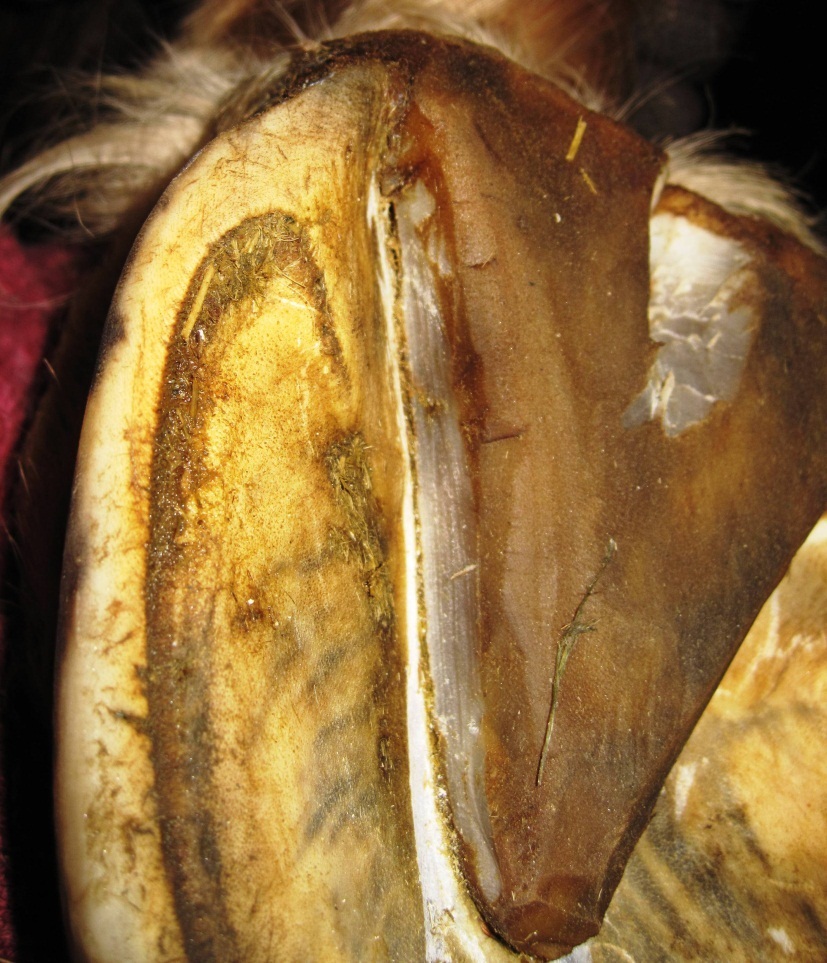
Once the frogs were restored to health, maintenance included occasional Oxine soakings (once weekly to once a month, depending on need, none for the last 6 months), application of Thrush Stop every time when trimming, about every 10 days to 2 weeks, and for the last 3 months No Thrush exclusively, applied about every 10 days. (Fig. 18 – 20)
Here are the same hooves 1 year later. The initial treatment had started 21 months ago.
Figure 18. Application of NoThrush to RF ( hoof in Fig. 15)
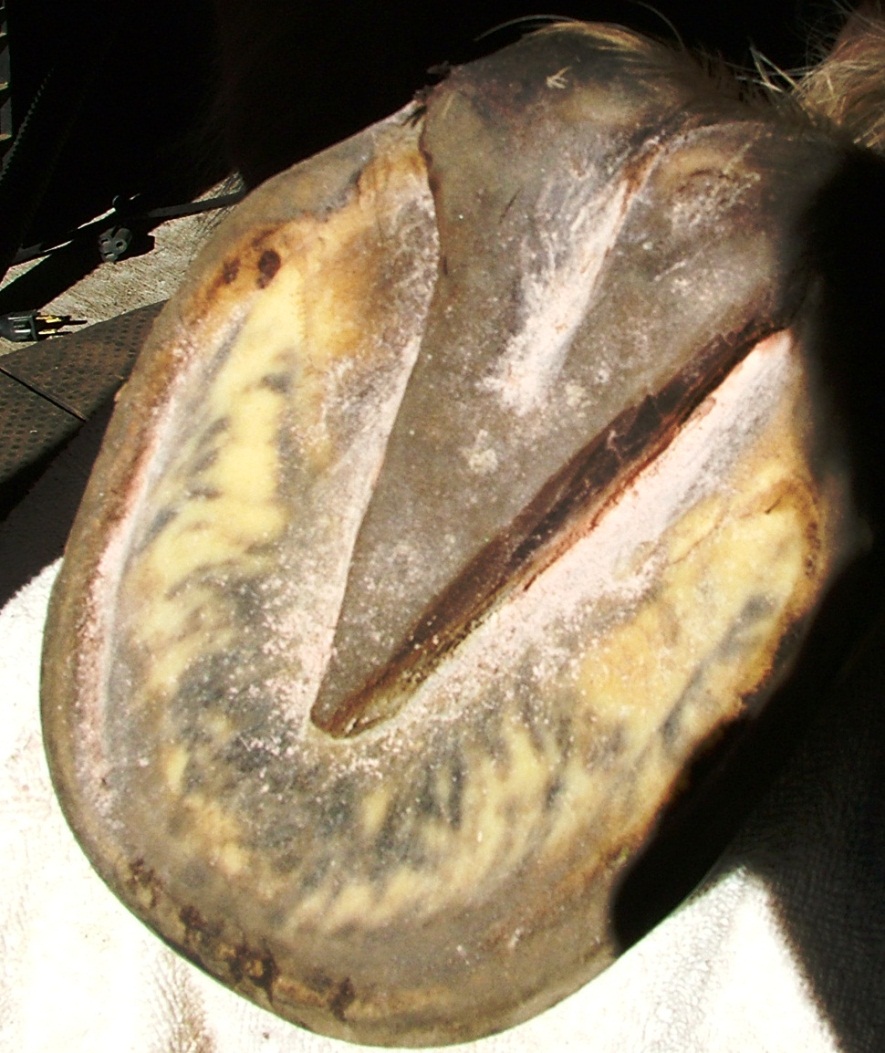
Figure 19. LF (hoof in Fig. 16) with NT applied
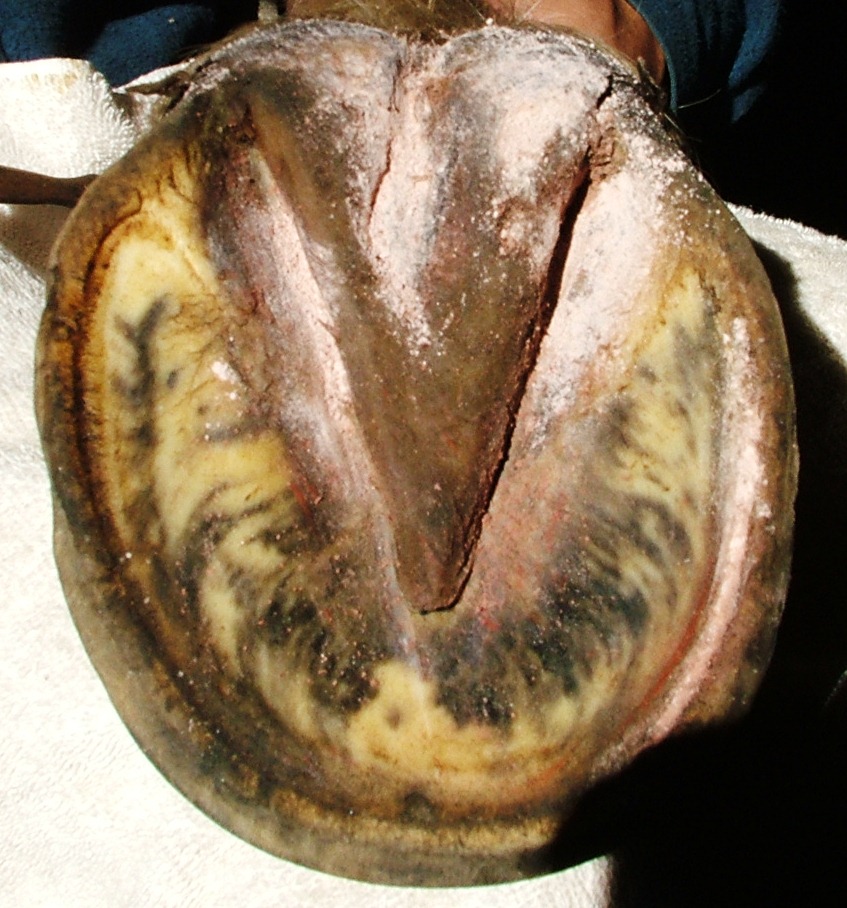
Figure 20. LH (hoof in Fig. 17) with No Thrush applied
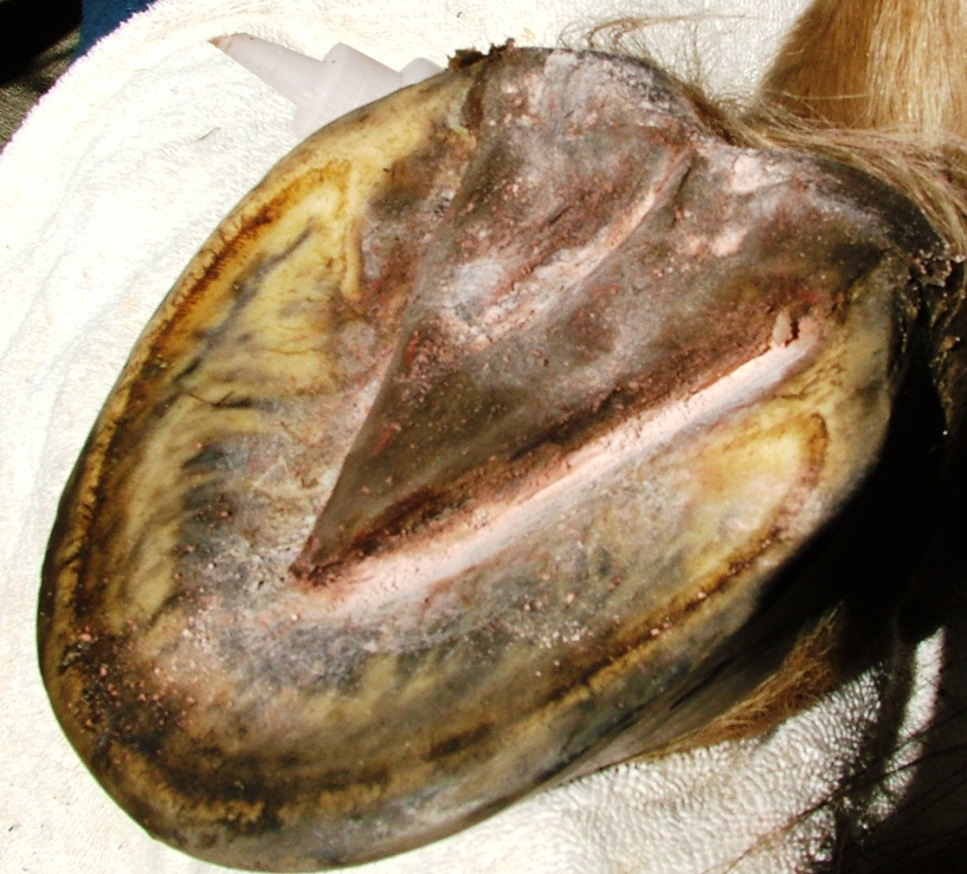
Although these frogs show some surface lesions, the main body of the frogs remains strong and healthy, and has never reverted back to the original problem. We are very pleased with the No Thrush, as it is easy to apply and seems to do an excellent job.
A new product just came to our attention, called Thrush Off, and we have heard great things about it. However, we have not tried it and can only encourage you to check it out for yourself.
Finally, according to the developers of Clean Trax, fungal infestation with the yeast organism Candida albicans may be the underlying cause of a myriad of hoof problems, including chronic occult frog disease. The insidious nature of this infection and its ability to form spores that are very difficult to kill, especially in dark places such as crevices in the hoof or stall floors, make it a challenge to identify and eradicate. According to this expert, infection with C. albicans facilitates opportunistic infections with many other pathogens, including those which cause overt thrush and abscesses.
We are currently evaluating the efficacy of Clean Trax with seven horses who have been treated assiduously with the products mentioned above. Although their frogs have responded well, therapy and prophylactic care is time intensive. Also, white line disease and thin soles in some of the horses have not been resolved and in two cases, have worsened. Hoof trim has been evaluated by multiple experts, and assessed radiographically. Improper trim cannot be blamed for these problems. None of the horses have foundered, and all have unlimited exercise on variable terrain including 4”-6” deep pea gravel in habitual “hangout” areas. In addition, all but the yearling are in full dressage training, including trail rides.
Hopefully, our next article will provide more insight into how Clean Trax fits into the puzzle of resolving hoof pathology in horses. Meanwhile, please feel welcome to contact us with your questions and experience. We may not know all the answers, but we will all learn as we work to make our horses more comfortable and athletic.
Heike Bean